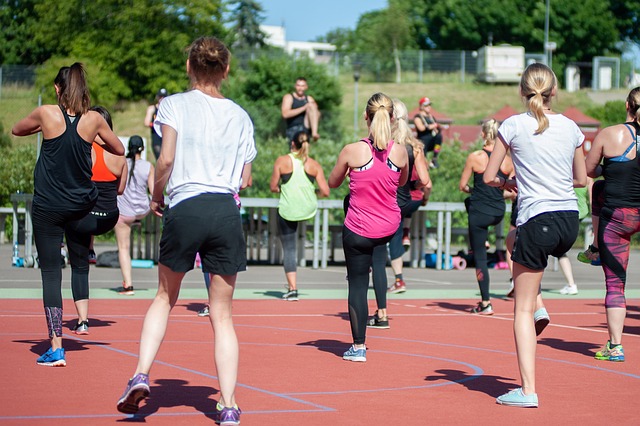305 Fitness is a dance-based workout that lives by the motto “make sweat sexy.” The program encourages body positivity with simple, entertaining dancing techniques and encouragement from passionate and friendly instructors.
Sadie Kurzban, an entrepreneur and dance enthusiast, founded 305 Fitness in New York City in 2016. The classes have the feel of a Miami dance club. Well-known DJs such as Tiesto (an investor in the endeavor) and others give a good beat backdrop to keep the intensity high and the fun element consistent.
Kurzban has stated that she created the program to educate people on how to speak to themselves with care and support, express delight, and shed layers of shame.
At 305 Fitness, dancers and non-dancers can get a good workout involving cardio and strength training.
305 Exercise Overview
305 Fitness boasts 1,000 certified instructors who teach outdoors, in dance studios, gyms, and online across the world (where reopening is possible). The lessons have an all-inclusive, dance-party vibe, with people of all shapes, sizes, and backgrounds participating.
Kurzban emphasizes that the lessons are available to everyone who wants to push themselves. She does, however, point out that the classes are high-energy and fast-paced, so it might not be the perfect workout for people searching for a calmer pace.
Format
The majority of classes are designed to include a cardio dance, a strength segment, and another dance cardio segment. The class offers conditioning exercises, and high-intensity interval training are all possibilities, and classes typically last 30 to 45 minutes.
There is no need for any special equipment. Light weights are recommended for participants searching for an added challenge. Don’t be concerned about what you’ll wear. Wear workout clothing, street clothes, or whatever makes you feel comfortable.
Feel
If you’re not familiar with the club scene, the music and mood of 305 Fitness courses may be overwhelming. However, no prior experience is required for the workout, and the dance techniques are rather simple to learn.
Many of the moves, such as grapevines, v-steps, and ponies, are stylized versions of moves that have been done in aerobic dance schools for years.
Choreography pieces are quite short, making them appear easy, and combinations are performed frequently, giving you plenty of chances to nail it.
If you do a lot of dance-inspired workouts, one thing you might notice about 305 instructors is their ability to cue movement such that the speed of the Activity does not slow down.
Even though the workouts have a club-like ambiance, they have a professional quality to them.
Cost
The cost of classes varies according to region. In 2020, the cost of socially separated outdoor programs ranged from roughly $20 to $30 for each class.
Some classes are available on YouTube for free. You may also subscribe to gain access to the entire collection of strength and cardio classes.
A one-year subscription is $149.99, or you can pay $28.99 each month if you subscribe monthly.
Calories expended
The company makes claims about how many calories you might burn during a class. The figures appear to be lofty and may be out of reach for the average home exerciser.
A 45-minute workout can burn 500 calories or more, according to the 305 Fitness website.
When asked about the figure, Sadie explains that they have been tracking energy expenditure. “We researched consumers using heart rate monitors in class and discovered that on average, a woman who weighs 150 lbs can burn somewhere between 500-700 calories in a 305 session.”
Of course, they were not formal, peer-reviewed, published research like those found in exercise physiology journals. And while the figures may reflect what participants experienced in certain classes, they may not exactly correspond to figures published by well-known fitness organizations.
According to experts, a person who weighs would only burn about 357 calories after 45 minutes of vigorous aerobic dance. If the Activity was moderate, the person would burn around 331 calories, whereas if it was casual, they would only burn around 255 calories.
Three exercises were performed in an online 305 Fitness session and burned an average of 8.6 calories per minute, equating to 387 calories in a 45-minute class.

A variety of factors can influence the number of calories burned during any physical exercise. Body size and exertion level, for example, will influence your energy expenditure. A calorie calculator can help you estimate how many calories you’ll burn during a typical workout.
Factors Influencing Your Energy Expenditure
There are several elements that can influence the number of calories burned during a 305 Fitness class:
Your dancing abilities:
If you learn the choreography quickly, you may be able to do the steps more intensely without stopping. On the other side, some newer participants may need to pause to figure out a move. When you stop, your heart rate will briefly calm down.
Body components used:
You will learn upper and lower body routines in a 305 Fitness class. You are invited to do whatever makes you feel most at ease. For example, people who are new to the classes may prioritize footwork before adding arm movements. You will burn more calories if you can do both arm and leg movements because you are using more of your body.
Your partner(s) in the dance:
If you respond well to a group exercise environment, you may burn more calories if you work out in a studio or with friends at home. Responding to the enthusiasm of others can sometimes help you get into the rhythm and move with more vigor. While there is no scientific evidence comparing group exercise to solo exercise, at least one study suggests that exercising with people has more health benefits.
Health Advantages
While there hasn’t been any published research specifically looking into the health advantages of 305 Fitness, there has been a slew of studies looking into the health benefits of dance fitness programs in general.
Life Quality Improvement
The study comprised 65 inactive women in their 30s and 40s who were randomly allocated to either a dance fitness class (3 times per week/60 minutes per session), a dance-fitness program with functional training, or no exercise class. The program lasted 16 weeks, and researchers were hoping to observe if the three groups’ quality of life scores changed.

Researchers discovered that people in the dancing fitness group had higher scores related to the following:
- Vitality
- Physical function
- Mental well-being
- Overall health
- Physical performance
- Social interaction
Women in the dance fitness/functional training group had higher quality of life scores as well, while the dance fitness-only group had considerably higher vitality scores. Their findings agreed with previous research that revealed that participating in dance fitness can assist in enhancing the quality of life.
Physical Activity that is easily accessible
A review published in the British Journal of General Practice identified exercise privatization as an issue that may have a role in the country’s under-activity, given that many of its residents are inactive. Many people cannot afford or refuse to pay “huge sums of money” to join a private health club.
According to the most recent CDC data, only one in every four adults and one in every five high school students meet the recommended physical activity guidelines.
And approximately 31 million adults aged 50 and older are inactive, meaning they get no physical activity beyond that required for daily living.
Widely available dancing classes provide possibilities to meet physical activity guidelines while also providing other benefits. According to Zoe Bremer, “the finest types of dance to encourage people to take up are those that build teamwork, either with a partner or within a set.”
Bremer goes on to state that dancing promotes physical health in varied degrees by increasing strength, suppleness, coordination, and balance and that “energetic” styles of dance give great aerobic exercise.
“Dancing is also a wonderful approach to increase physical fitness and social skills, hence enhancing mental health,” explains Bremer.
Dancing is also a fantastic way to increase physical fitness and social skills. It also boost mental health, and it is something that can be started early in life and continue to bring enjoyment long into retirement.
Classes like those provided by 305 Fitness online, in studios, and in community settings do not necessitate the purchase of a costly gym membership, and many of them are free. Participants can complete the online classes at their leisure and in whichever location they like.
Physical and mental performance has improved.
Several studies have compared structured dancing courses to other forms of structured exercise programs in terms of physical health outcome indicators. One comprehensive research review looked at 28 studies with a total sample size of 1,276 people. The authors of the study included trials in which participants participated in a dance or other exercise program for at least four weeks.
Dance therapies significantly improved body composition, blood biomarkers, and musculoskeletal function, according to the study authors’ meta-analyses.
Dance fitness and other forms of exercise both increased cardiovascular function and perceived mobility.
Another study found that dance training is more effective than other types of repetitive physical Activity in promoting brain plasticity in older persons.
How It Measures Up
You might be tempted to attempt some additional dance-inspired routines. Each has its own advantages, and no workout is inherently superior to the others. However, they differ slightly.
Zumba has been in existence since the mid-1990s. The workout usually includes Latin-inspired dance maneuvers because it was created by a Columbian dancer. However, as the business grew and spread, new instructors added their own spin to the workouts. The cost of classes varies by area, but they can be as little as $5 for each session.

Zumba classes, like 305 Fitness, tend to favor cardio over strength training, while the brand has expanded to include various workout forms.
In a regular Zumba class, you will typically learn one long dance that you will practice for multiple classes. In contrast, you may master numerous smaller movement blocks in a single 305 Fitness lesson.
Zumba instructors often use visual cues rather than verbal cues. In other words, in a Zumba class, you observe and follow your instructor (although different instructors have different styles).
Jazzercise
Jazzercise is the world’s largest dance fitness franchise corporation. Most likely its most well-known brand, particularly among women aged 35 and up. Judi Sheppard Missett launched the company in 1969, and it rose to prominence in the 1980s and 1990s.
The moves were originally based on jazz dance-style choreography for a cardio workout. Since then, the brand has evolved and now provides current music, contemporary dances, and a wider range of classes such as HIIT, Pilates, strength training, and other workout genres.
Jazzercise classes can be found in gyms, studios, schools, and community centers. Prices vary by location and may be charged per class or need a membership. Jazzercise courses are now available online for $19.99 per month.
Classes in Barre
Barre courses, such as those offered by Pure Barre or The Bar Method, have grown in popularity in recent years. However, despite the fact that this workout is dance-based, there are few parallels across the routines.
Barre workouts typically include ballet-based movements, such as exercises that increase flexibility, posture, and strength. While your heart rate is likely to rise during a barre session, it is not considered a cardiac workout.
You practice repeats of plié variations, relevé, battement, and other adapted ballet exercises rather than choreography.
To Conclude
If you are a “social butterfly,” I believe this dance-based workout fitness routine is for you. Dancing, according to certain research, is good for your mental health because you must memorize steps.
If your regular exercise routine is becoming monotonous, you could consider dancing to keep fit.


